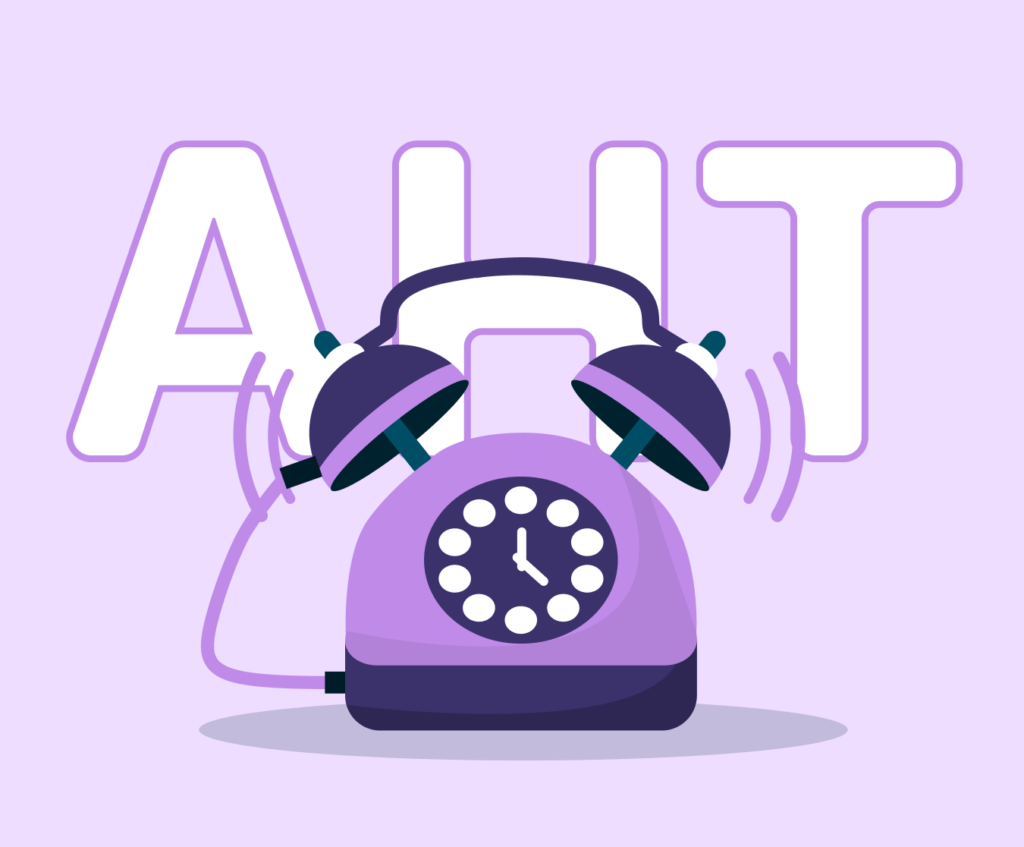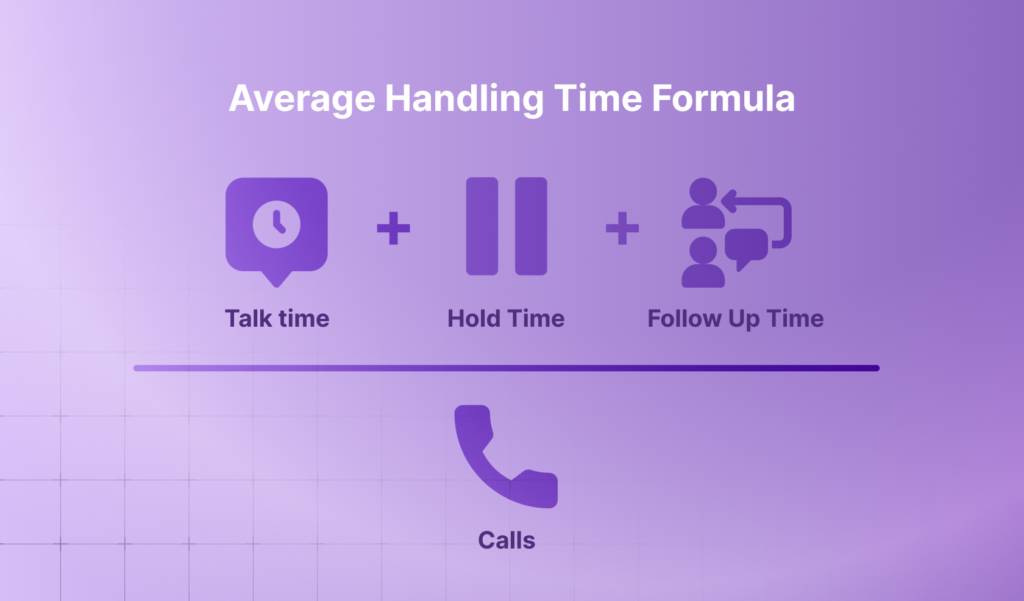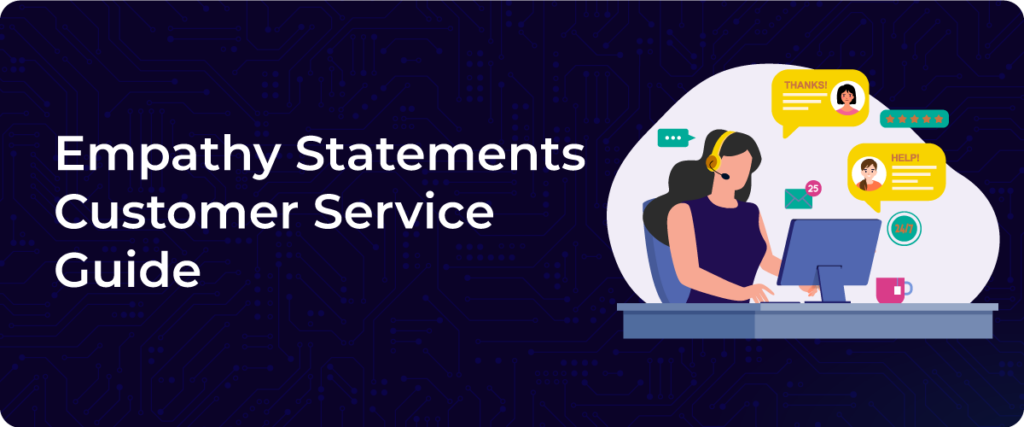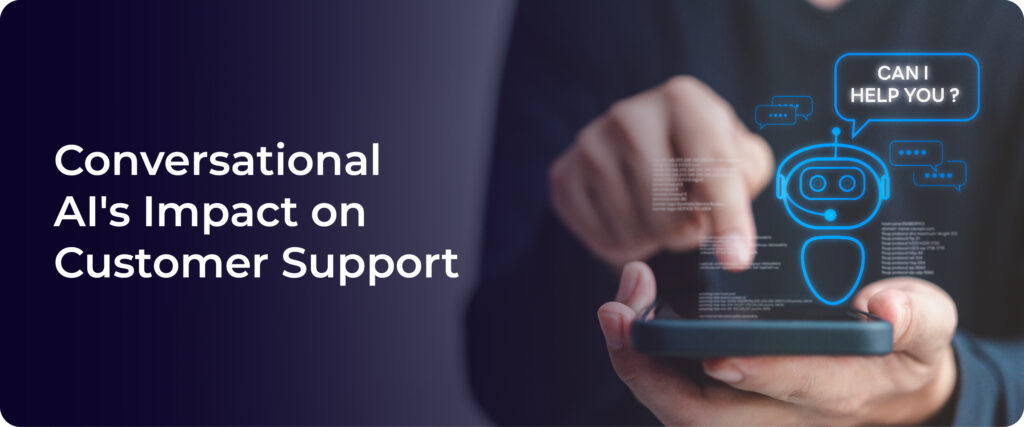
Average Handle Time (AHT) in call center refers to the average time it takes for a customer service representative to handle a call or chat interaction from start to finish
One of the most critical metrics for checking the immense pressure and to manage customer interactions effectively is Average Handling Time. This metric helps businesses understand how long agents spend on each customer interaction, from answering the call to finishing the follow-up tasks.
A lower AHT generally means faster service, but maintaining a balance between speed and customer satisfaction is essential.
In this blog, we’ll explore everything you need to know about AHT, its formula, and proven tips to reduce it without compromising quality.
Table of Contents
- What is Average Handle Time (AHT)?
- What’s a good Average Handle time?
- Average Handle Time Benchmark for Different Industries
- Why is Average Handle Time Important?
- How to Calculate Average Handle Time?
- 11 Tips to Reduce Average Handle Time in a Call Center
- Limitations of the AHT Formula
- How to Improve Average Handle Time (AHT)?
- Why Average Handle Time Matters for Your Business?
- Balance Between Quality and Speed
- Reduce AHT with ConvozenAI
- FAQs on average handle time
What is Average Handle Time (AHT)?
Average handling time refers to the average time it takes for a customer service representative to handle a call or chat interaction from start to finish. It includes the time spent talking to the customer, putting the customer on hold, and completing any necessary after-call work.
AHT formula
To calculate AHT, you need to take the sum of the following:
- Talk Time: The actual time the agent spends speaking with the customer.
- Hold Time: The time the customer is placed on hold during the call.
- After-Call Work (ACW): The time taken by the agent to finish administrative tasks after the call has ended.
The AHT formula is:
Average Handle Time (AHT) = (Talk Time + Hold Time + After-Call Work) / Total Number of Calls Handled
For example, if an agent spends 200 minutes handling 10 calls, with a combination of talk, hold, and after-call work, the AHT would be:
AHT = 200 minutes / 10 calls = 20 minutes

What’s a Good Average Handle time?
There is no universal standard for what is a good Average Handle Time because it depends on the industry, the complexity of customer queries, and the call center’s objectives.
For example, a technical support center may have a higher AHT due to the complexity of inquiries, whereas a retail support center may aim for shorter AHTs. However, in general, call centers aim for an AHT between 6 to 8 minutes.
Average Handle Time Benchmark for Different Industries
Benchmarks for AHT vary for different industries. Here’s how:
- Retail: 3–4 minutes
- Banking & Financial Services: 4–6 minutes
- Telecommunications: 5–7 minutes
- Technical Support: 8–10 minutes
- Healthcare: 6–8 minutes
- Insurance: 5–7 minutes
Why is Average Handle Time Important?
AHT is important because it directly impacts the customer experience and operational efficiency:
1. Customer Satisfaction
A shorter AHT usually means faster service, but if rushed, it can lead to poor issue resolution. A balance is key.
2. Operational Efficiency
Reducing Average Handle Time helps call centers handle more calls with fewer resources, cutting costs and improving agent productivity. By monitoring AHT, managers can identify bottlenecks in processes, inefficiencies in agents’ performance, and opportunities to enhance training.
How to Calculate Average Handle Time(AHT)?
If you’re tracking Average Handle Time (AHT) regularly and notice that your average call handle time appears to be stable it could be a sign that your current processes are working well for which understanding how to calculate AHT is essential for tracking performance:
To calculate AHT
AHT = (Talk Time + Hold Time + After-Call Work) / Total Number of Calls Handled
To make it easier, many companies use an AHT calculator, a tool designed to input data and instantly compute the metric. Tracking this data over time allows managers to monitor trends and make informed decisions.
11 Tips to Reduce Average Handle Time in a Call Center
Improving Average Handling Time requires a combination of tools, training, and process optimization. Here are 11 proven tips to help reduce Average Handle Time in a call center:
1. Provide Comprehensive Training
Well-trained agents can handle customer inquiries efficiently, reducing hold time and after-call work.
2. Use Call Scripts Wisely
Scripts can help streamline interactions, but agents should adapt to the situation instead of sticking rigidly to the script.
3. Leverage Call Routing Systems
Directing calls to the most appropriate agent reduces time spent transferring calls or escalating issues.
4. Invest in Call Monitoring Tools
Real-time monitoring tools can provide feedback and help identify where time is being lost.
5. Implement Knowledge Bases
A centralized knowledge base helps agents quickly access information without searching through multiple systems.
6. Encourage First Call Resolution (FCR)
Resolving an issue on the first call eliminates the need for multiple interactions, thus reducing AHT.
7. Minimize After-Call Work
Automating repetitive after-call tasks with CRM integrations or software can reduce administrative time.
8. Streamline Internal Communication
Reducing the need to consult with other departments or supervisors can save significant time.
9. Use AI-Powered Chatbots for Simple Queries
Automating simple queries allows agents to focus on more complex interactions, reducing overall AHT.
10. Track Performance Regularly
Use data to monitor agents’ AHT and offer constructive feedback to encourage continuous improvement.
11. Optimize Hold Time
Ensure that hold times are minimized by providing agents with the tools they need to resolve issues quickly.
Check out our guide on improving sales team efficiency with Sales Enablement Tools
Limitations of the AHT Formula
Though AHT is a valuable metric, it does have limitations:
1. Lack of Insight into Quality
A low AHT might indicate efficiency, but it doesn’t measure the quality of the interaction or whether the customer’s issue was resolved.
2. Agent Burnout
Pressuring agents to constantly reduce AHT without considering the complexity of calls can lead to stress and burnout.
3. Focus on Numbers Over People
Solely focusing on AHT can shift attention away from the agent’s well-being or customer satisfaction.
How to Improve Average Handle Time (AHT)?
If you’re wondering how to improve AHT, focus on training, technology, and streamlined processes. Enhancing the quality of your customer interactions while keeping them efficient is key to lowering your AHT without sacrificing customer experience.
Here are 8 tips to reduce average handle time in a support center:
1. Automation of Routine Tasks
Automate repetitive tasks like data entry to allow agents to focus on resolving customer issues.
2. Provide Real-Time Analytics
Tools that offer real-time feedback can help agents improve during calls.
3. Use Predictive Dialers
These systems help ensure that agents are only dealing with live calls, reducing time spent on failed connections or wrong numbers.
4. Optimize Call Scripts
Ensure that scripts are concise, and flexible, and provide agents with clear guidelines.
5. Continuous Agent Coaching
Regular training and feedback can help agents reduce AHT through more effective handling techniques.
6. Pre-Call Preparation
Ensure that agents have access to customer information before the call to minimize time spent retrieving data during the call.
7. System Integration
Integrate all necessary tools, so agents don’t waste time toggling between multiple platforms.
8. Monitor Call Transfers
Reduce the number of transfers by routing calls to the right agent the first time.
Read Also: 7 Sales Growth Strategies
Why Does Average Handle Time Matters for Your Business?
A lower AHT means faster service, higher call volume, and greater customer satisfaction, but it also impacts business operations in other ways:
1. Reduced Operating Costs
By improving average handling time, businesses can handle more calls with fewer resources, ultimately reducing operational expenses.
2. Better Resource Allocation
With lower AHT, teams can focus on other business priorities, such as outbound sales calls or complex support tasks.
Strike a Balance Between Quality and Speed
While reducing AHT is beneficial for improving efficiency, it’s essential to maintain high-quality customer service. If agents rush to complete calls just to reduce their Average Handle Time, it may lead to unresolved issues or frustrated customers. Focus on balancing speed with customer satisfaction for optimal results.
Reduce AHT with ConvozenAI
Reducing Average Handle Time while maintaining quality can be challenging, but tools like ConvoZen.AI can help. With real-time monitoring, automated feedback, and powerful analytics, ConvoZen.AI enables call centers to lower AHT, increase productivity, and enhance customer satisfaction.
Ready to reduce your AHT? Contact ConvoZen.AI to book a demo and see how our solutions can transform your call center operations!
FAQs
AHT refers to the total time an agent spends handling a customer interaction, including talk time, hold time, and after-call work.
A good AHT varies by industry but generally falls between 6 to 8 minutes for most customer service centers.
The AHT formula:
AHT = (Talk Time + Hold Time + After-Call Work) / Total Number of Calls Handled
Focus on agent training, automation of repetitive tasks, real-time feedback, and optimizing call routing systems.
Average Handle Time (AHT) is a Key Performance Indicator (KPI) that measures the average duration it takes for a call center agent to handle customer interaction, including talk time, hold time, and after-call work.
It is possible to improve efficiency and balance quality by identifying and analyzing your AHT data, providing agents with the necessary resources to efficiently resolve calls, and tracking customer satisfaction and experience at the same time with AHT.
AHT analysis is the review of call data to identify patterns, anomalies, and opportunities for improvement to enhance performance.
AHT has an impact on workforce requirements, potential costs of the operational footprint, and levels of customer satisfaction; this means finding the balance between efficiency and quality of service delivery of customer interactions.


